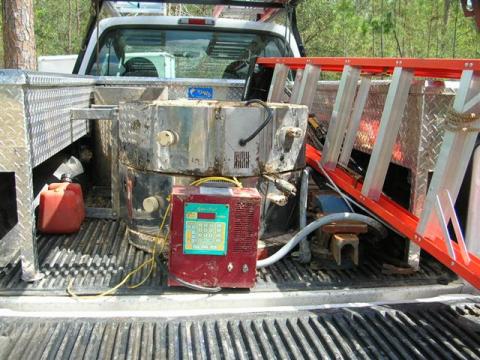Safety Note: Never plug in or power on a kiln that has been flooded. Water and electricity are a deadly combination. Always consult a qualified electrician before touching any submerged equipment.
Why Flood Water Destroys Kilns
When a kiln is exposed to flooding—especially in hurricanes or major storms—the damage often goes far beyond the surface. Firebricks are highly porous and can absorb a significant amount of water, sometimes up to a pint per brick. That water doesn’t just sit there—it becomes trapped inside.
If the kiln is later fired while this moisture is still present, the water turns to steam and expands rapidly. This can cause the bricks to crack or even explode. Worse still, if the floodwater came from a storm surge or runoff, it likely carried salt and minerals that contaminate and corrode the internal parts of the kiln, especially the metal case and heating elements.
Parts That Rarely Survive Submersion
Firebricks and Kiln Shelves:
These absorb water deeply and can take weeks to dry fully in ideal conditions. Even then, they may never return to their original strength and are prone to spalling when fired.
Heating Elements and Thermocouples:
Salt and sediment from floodwater reduce conductivity and can cause premature failure. Attempting to reuse them is risky and may cause uneven or unsafe firing.
Control Panels and Wiring:
Most modern kilns have complex electronic controllers. Even a splash can short out a circuit board, and full submersion almost always renders the controller unusable. Replacing the panel is often more cost-effective than attempting repair.
Limited Steps You Can Try
If you’re determined to evaluate your kiln, follow these steps carefully:
- Document the Damage
Take clear photos of the water line, interior, control panel, and all visible corrosion. These will be essential for any insurance claim. - Disassemble What You Can (Safely)
Remove the control box and any external components that are clearly water-damaged. Do not reconnect or power anything. - Air-Dry the Kiln Room
Run a dehumidifier in the kiln room for at least 1–2 weeks. Keep humidity under 50% and allow the kiln to sit with the lid open and panels removed. - Test Shelves Separately
If shelves appear undamaged, kiln wash them, then test-fire them in a separate kiln before reuse. Be aware they may still fail from hidden moisture. - Do Not Attempt a DIY Bake-Out
Putting bricks in a household oven or heating with space heaters rarely works and often causes more damage. Controlled industrial drying is rarely worth the cost for hobby or school kilns.
Filing an Insurance Claim
Most insurance policies will consider a flooded kiln a total loss. To support your claim:
- Provide serial numbers and model information
- Include your original invoice or proof of purchase
- Attach the photos you took of the damage
- Request a replacement quote from the manufacturer or your distributor
Be sure to note that kilns are specialized equipment, and replacement costs may exceed general appliance allowances in your policy.
When to Replace, Not Repair
If water reached the control panel, element terminals, or wiring—even briefly—replacement is usually the safest and most cost-effective choice. Salvaging individual parts may seem frugal but can lead to ongoing reliability issues, electrical hazards, or costly downtime.
For questions about replacing your kiln or help choosing the right model, contact us or explore our kiln selection guide.




